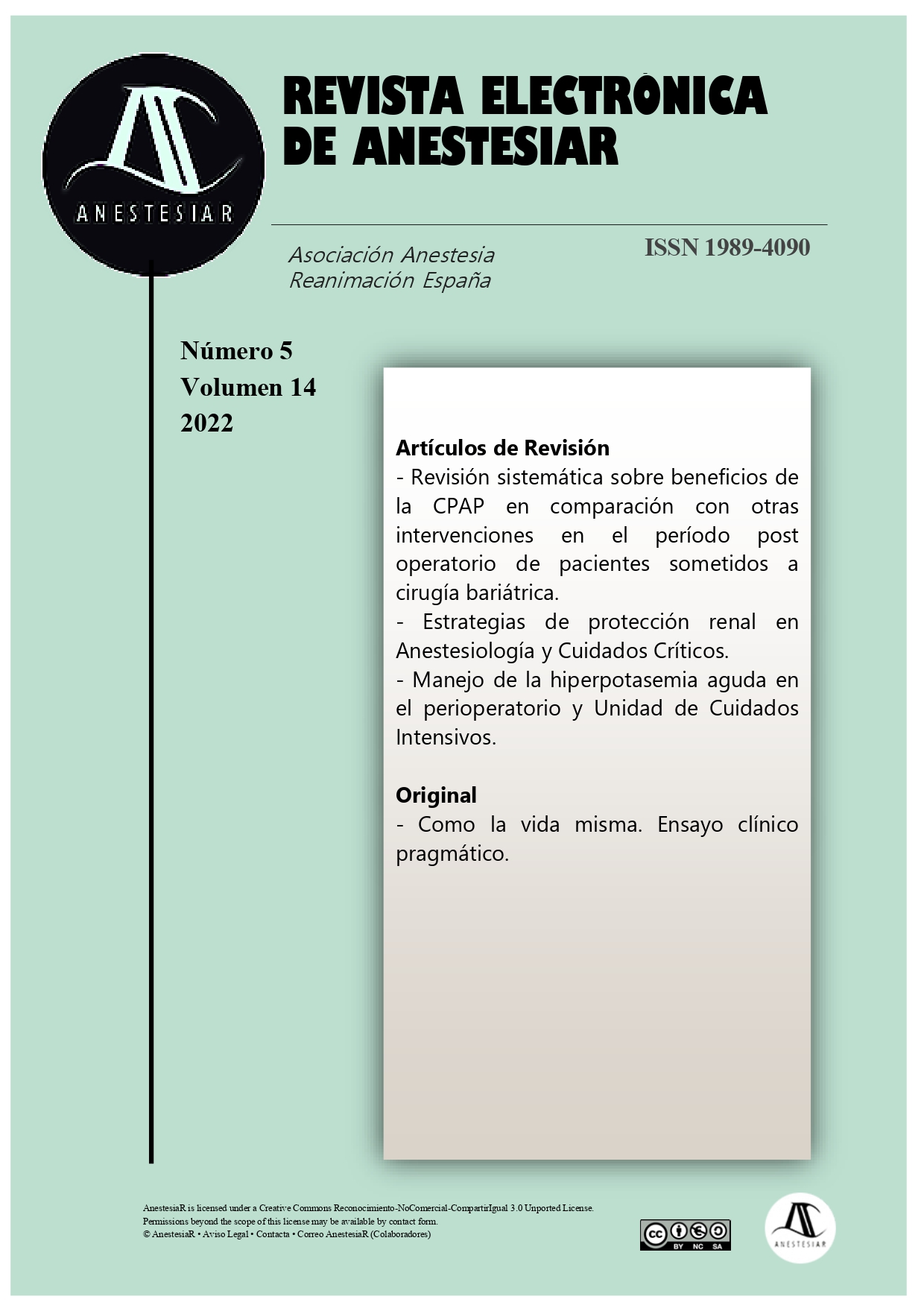Renoprotection strategies in Anesthesiology and Critical Care
DOI:
https://doi.org/10.30445/rear.v14i5.1010Keywords:
perioperative renoprotection, acute kidney injury, Contrast‐induced nephropathy, nephrotoxicity, perioperative periodAbstract
In the perioperative setting, acute kidney injury (AKI) is a common complication. By itself, the presence of AKI is associated with adverse outcomes, such as increased risk of chronic kidney disease and mortality. Several risk factors are associated with the appearance of perioperative AKI and identifying them is crucial to initiate renal protective measures. Some renoprotective strategies have been shown to be helpful, others are still under investigation, and others are no longer recommended because they are ineffective or even harmful. The lack of efficacy of these therapies could be due to the fact that the therapy was started too late. The new renal biomarkers allow the identification of kidney damage without loss of function, thus allowing the implementation of preventive measures. The purpose of this review is to present an updated summary of the current evidence about the risk factors and mechanisms that lead to the appearance of AKI in the perioperative and the intensive care unit, as well as the different renoprotective strategies and treatments.
References
Molinari L, Sakhuja A, Kellum JA. Perioperative Renoprotection: General Mechanisms and Treatment Approaches. Anesth Analg. 2020;131(6):1679-92.
Saadat-Gilani K, Zarbock A, Meersch M. Perioperative Renoprotection: Clinical Implications. Anesthesia & Analgesia. diciembre de 2020;131(6):1667–1678.
Yang Y, Song M, Liu Y, Liu H, Sun L, Peng Y, et al. Renoprotective approaches and strategies in acute kidney injury. Pharmacol Ther. 2016; 163:58-73.
O’Sullivan KE, Byrne JS, Hudson A, Murphy AM, Sadlier DM, Hurley JP. The effect of obesity on acute kidney injury after cardiac surgery. J Thorac Cardiovasc Surg. diciembre de 2015;150(6):1622-8.
Portela-Ortiz JM, García-Hernández L, Delgadillo-Arauz C. Protección renal en el perioperatorio. 2016;6.
Sun LY, Beattie WS. Association of Intraoperative Hypotension with Acute Kidney Injury after Elective Noncardiac Surgery. PERIOPERATIVE MEDICINE. :9.
An R, Pang Q-Y, Liu H-L. Association of intra-operative hypotension with acute kidney injury, myocardial injury and mortality in non-cardiac surgery: A meta-analysis. Int J Clin Pract. octubre de 2019;73(10): e13394.
Futier E, Lefrant J-Y, Guinot P-G, Godet T, Lorne E, Cuvillon P, et al. Effect of Individualized vs Standard Blood Pressure Management Strategies on Postoperative Organ Dysfunction Among High-Risk Patients Undergoing Major Surgery: A Randomized Clinical Trial. JAMA. 10 de octubre de 2017;318(14):1346-57.
Tumlin JA, Murugan R, Deane AM, Ostermann M, Busse LW, Ham KR, et al. Outcomes in Patients with Vasodilatory Shock and Renal Replacement Therapy Treated with Intravenous Angiotensin II. Crit Care Med. junio de 2018;46(6):949-57.
Garzotto F, Ostermann M, Martín-Langerwerf D, Sánchez-Sánchez M, Teng J, Robert R, et al. The Dose Response Multicentre Investigation on Fluid Assessment (DoReMIFA) in critically ill patients. Critical Care. 23 de junio de 2016;20(1):196.
Raimundo M, Crichton S, Martin JR, Syed Y, Varrier M, Wyncoll D, et al. Increased Fluid Administration After Early Acute Kidney Injury is Associated with Less Renal Recovery. Shock. noviembre de 2015;44(5):431-7.
Myles PS, Bellomo R, Corcoran T, Forbes A, Peyton P, Story D, et al. Restrictive versus Liberal Fluid Therapy for Major Abdominal Surgery. N Engl J Med. 14 de junio de 2018;378(24):2263-74.
Ehrmann S, Aronson D, Hinson JS. Contrast-associated acute kidney injury is a myth: Yes. Intensive Care Med. enero de 2018;44(1):104-6.
Possible prevention and therapy of ischemic acute tubular necrosis - UpToDate [Internet]. Disponible en: https://www.uptodate.com/contents/possible-prevention-and-therapy-of-ischemic-acute-tubular-necrosis?search=pischemic%20acute%20tubular%20necrosis&source=search_result&selectedTitle=2~150&usage_type=default&display_rank=2
Deng Y, Yuan J, Chi R, Ye H, Zhou D, Wang S, et al. The Incidence, Risk Factors and Outcomes of Postoperative Acute Kidney Injury in Neurosurgical Critically Ill Patients. Sci Rep [Internet]. 26 de junio de 2017;7. Disponible en: https://www.ncbi.nlm.nih.gov/pmc/articles/PMC5484679/
Palli E, Makris D, Papanikolaou J, Garoufalis G, Tsilioni I, Zygoulis P, et al. The impact of N-acetylcysteine and ascorbic acid in contrast-induced nephropathy in critical care patients: an open-label randomized controlled study. Crit Care [Internet]. 31 de octubre de 2017 [citado 5 de enero de 2021];21. Disponible en: https://www.ncbi.nlm.nih.gov/pmc/articles/PMC5664844/
Lakhal K, Ehrmann S, Robert-Edan V. Iodinated contrast medium: Is there a re(n)al problem? A clinical vignette-based review. Critical Care. 10 de noviembre de 2020;24(1):641.
Downloads
Published
How to Cite
Issue
Section
License
Copyright (c) 2022 Revista Electrónica AnestesiaR

This work is licensed under a Creative Commons Attribution-ShareAlike 4.0 International License.
 Envío y derechos de autor
Envío y derechos de autor


 Revista Electrónica AnestesiaR by
Revista Electrónica AnestesiaR by 